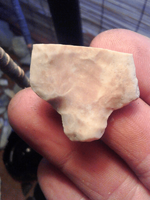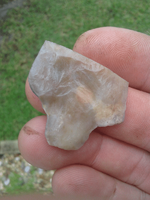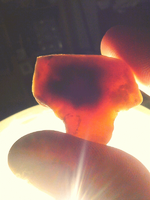Upvote
0
You are using an out of date browser. It may not display this or other websites correctly.
You should upgrade or use an alternative browser.
You should upgrade or use an alternative browser.
Found A Big One Today
- Thread starter Americus
- Start date
- Mar 5, 2010
- 7,500
- 11,872
- Detector(s) used
- XP Deus, White's DFX
- Primary Interest:
- All Treasure Hunting
It's a shame that second point is broken. It looks like a fresh break.
old digger
Gold Member
- Jan 15, 2012
- 7,502
- 7,298
- Detector(s) used
- White's MXT
- Primary Interest:
- All Treasure Hunting
Well Done! Looks pretty good to me, and a shame on the damage on the smaller one.
muttandjeeps
Full Member
- Jul 11, 2008
- 239
- 171
- Detector(s) used
- The Equinox 800 is the only one I need...
- Primary Interest:
- All Treasure Hunting
The white one has a great style, and the big one is big! Still looking to find one that size.
EricTheCat
Sr. Member
Great finds. Thank you for sharing.
On the white one it is interesting that the broken parts happen to show a dark interior. Do the stones in your area generate a white patina over time or is that just coincidence on that one? Maybe it was out in the sun for a really, really long time?
On the white one it is interesting that the broken parts happen to show a dark interior. Do the stones in your area generate a white patina over time or is that just coincidence on that one? Maybe it was out in the sun for a really, really long time?
willjo
Bronze Member
- Apr 30, 2015
- 1,069
- 2,014
- Detector(s) used
- Garrett GTA 350 and Garrett ace 150
- Primary Interest:
- All Treasure Hunting
Those are amazing, and it is more amazing that one that big survived all these years dodging farm equipment.
- Thread starter
- #7
Great finds. Thank you for sharing.
On the white one it is interesting that the broken parts happen to show a dark interior. Do the stones in your area generate a white patina over time or is that just coincidence on that one? Maybe it was out in the sun for a really, really long time?
A lot of my finds have the white patina on it.
GatorBoy
Gold Member
- May 28, 2012
- 14,716
- 6,149
- Primary Interest:
- All Treasure Hunting
Nice finds.
I guess a lot of folks don't realize most of the points you find or anyone for that matter in southwest Georgia and most of Florida have a lot of patina and the colors you see on the exterior are not the color of the original stone except of course some water finds and some in very sandy areas
I guess a lot of folks don't realize most of the points you find or anyone for that matter in southwest Georgia and most of Florida have a lot of patina and the colors you see on the exterior are not the color of the original stone except of course some water finds and some in very sandy areas
- Mar 5, 2010
- 7,500
- 11,872
- Detector(s) used
- XP Deus, White's DFX
- Primary Interest:
- All Treasure Hunting
I have used mineral oil to bring back the color on some of my broke points.
EricTheCat
Sr. Member
Thank you for the info guys. I found it interesting as a beginner how extreme (and thick) the patina can be on something made relatively recent in geological terms (though ancient of course). I have known and seen patina in lesser extents. It is helpful to know how it can look in different conditions.
EricTheCat
Sr. Member
Good to know. In geological terms 9,000 years is not that long ago even if it is seriously ancient to us (that is all I meant by relatively recent). What led me to ask about it is that I can find natural flint pieces around here that may show some discoloration over time (evident if you break it, or if it has a fresh break) but not nearly as extreme as that piece. It seems like the banded flint specimens I find would have faded to white if they were at Americus' location. Anyway I did not mean to derail this thread, thanks again for the info.
Trooper733
Sr. Member
- Apr 3, 2013
- 388
- 315
- Detector(s) used
- Whites V3i,Whites DFX, Whites TRX, Garrett Pro Pointer
- Primary Interest:
- Other
The broken area of the white point is similar in appearance to some chert nodules I've seen with an outer cortex formed over time. when you break them open or spall them for flakes for knapping the cortex is removed to use the more desirable interior. Maybe the age of this point allowed the natural formation of the cortex to reform over time and the right conditions similar to untouched nodes of chert or flint in nature?
GatorBoy
Gold Member
- May 28, 2012
- 14,716
- 6,149
- Primary Interest:
- All Treasure Hunting
The cortex on chert is limestone.
Chert is...silica replaced limestone.
The patina is not limestone though I see and understand the similarity in appearance.
It is a similar process in which groundwater was responsible for the mineral deposit or replacement
Chert is...silica replaced limestone.
The patina is not limestone though I see and understand the similarity in appearance.
It is a similar process in which groundwater was responsible for the mineral deposit or replacement
Trooper733
Sr. Member
- Apr 3, 2013
- 388
- 315
- Detector(s) used
- Whites V3i,Whites DFX, Whites TRX, Garrett Pro Pointer
- Primary Interest:
- Other
Thanks, learned something new. What would cause this in the point in question? It would seem like the cortex on this point would have been removed during the knapping process or at least show through at edges etc? Of course im not familiar with the substrate of this point either so I'm asking respectfully.
GatorBoy
Gold Member
- May 28, 2012
- 14,716
- 6,149
- Primary Interest:
- All Treasure Hunting
Heavy patina is common in southwest Georgia and a lot of Florida.
Without getting too complicated there's a pretty heavy mixture of pH and minerals in that area.
There's a lot of guys in the south that clarify that white patina by soaking their points in mineral oil sometimes it goes completely clear in only a couple minutes sometimes a couple days but it will always go back once it dries out again sometimes that could take months or longer
Without getting too complicated there's a pretty heavy mixture of pH and minerals in that area.
There's a lot of guys in the south that clarify that white patina by soaking their points in mineral oil sometimes it goes completely clear in only a couple minutes sometimes a couple days but it will always go back once it dries out again sometimes that could take months or longer
Last edited:
Hot diggity
Sr. Member
- Nov 19, 2014
- 441
- 313
Yes! Very nice finds Americus. I can only wonder how many amazing stone tools you have. Thank you too gator for the experiment. I've been reluctant to clean any of my stone in fear of erasing that old authentic look. If some of that will reappear later though, maybe it's time I tried it myself. Mineral oil. Congrats Americus!
Top Member Reactions
-
 2282
2282 -
 1114
1114 -
 1027
1027 -
 912
912 -
 863
863 -
 767
767 -
 754
754 -
 736
736 -
 608
608 -
 503
503 -
 490
490 -
 480
480 -
 430
430 -
 421
421 -
O
417
-
 407
407 -
 401
401 -
 395
395 -
 378
378 -
 370
370
Users who are viewing this thread
Total: 2 (members: 0, guests: 2)










